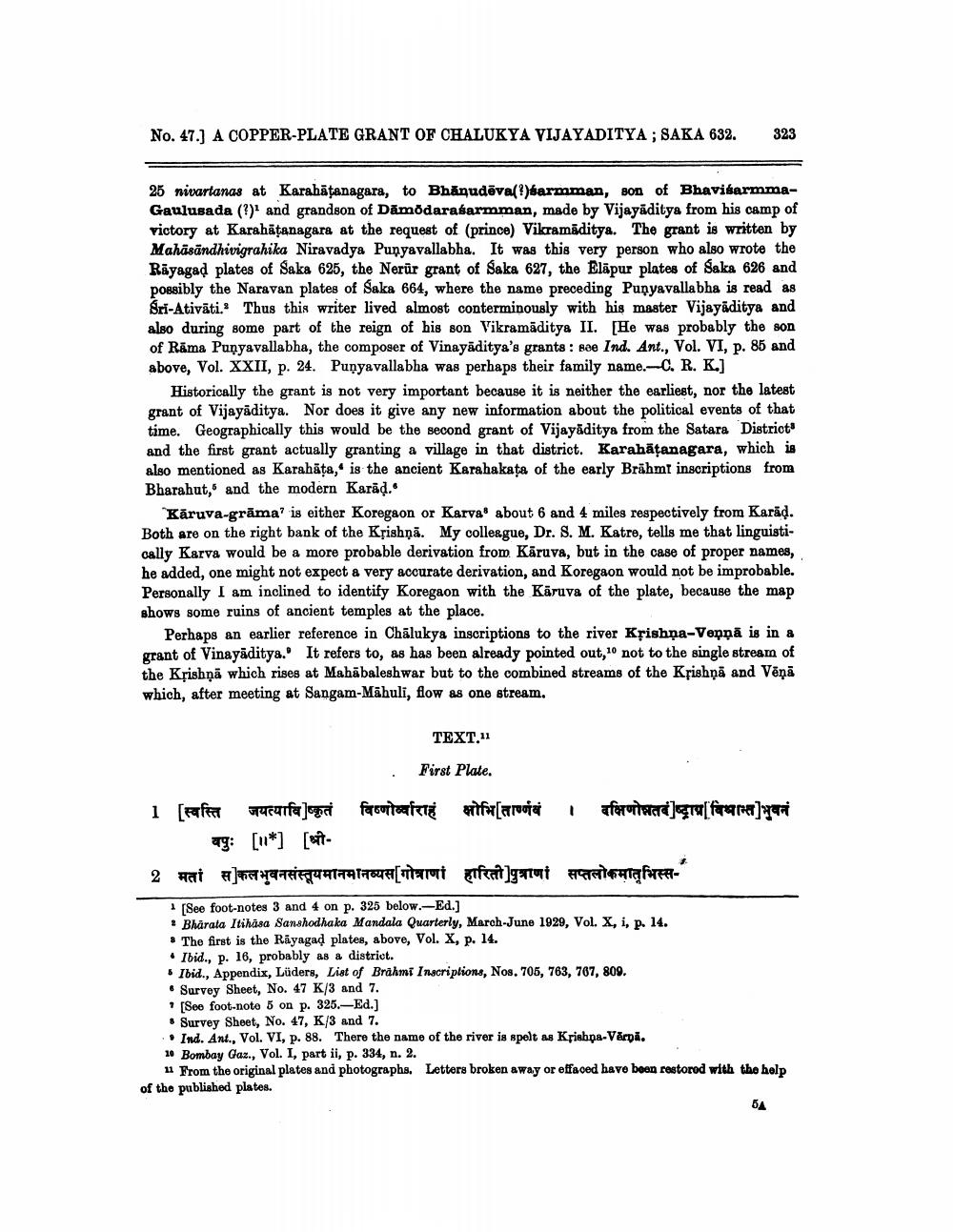________________
No. 47.) A COPPER-PLATE GRANT OF CHALUKYA VIJAYADITYA; SAKA 632.
323
25 nivartanas at Karahātanagara, to Bhānudēval')karmman, son of BhavisarmmaGaulusada (?) and grandson of Damodarafarmman, made by Vijayāditya from his camp of victory at Karahātanagara at the request of (prince) Vikramāditya. The grant is written by Mahāsāndhivigrahika Niravadya Punyavallabha. It was this very person who also wrote the Rüyagad plates of Saka 625, the Nerür grant of Saka 627, the Eläpur plates of Saka 626 and possibly the Naravan plates of Saka 664, where the name preceding Punyavallabha is read as Sri-Ativāti. Thus this writer lived almost conterminously with his master Vijayāditya and also during some part of the reign of his son Vikramaditya II. [He was probably the son of Rāma Punyavallabha, the composer of Vinayāditya's grants : see Ind. Ant., Vol. VI, p. 85 and above, Vol. XXII, p. 24. Punyavallabha was perhaps their family name.-C. R. K.]
Historically the grant is not very important because it is neither the earliest, nor the latest grant of Vijayaditya. Nor does it give any new information about the political events of that time. Geographically this would be the second grant of Vijayaditya from the Satara District and the first grant actually granting a village in that district. Karahātanagara, which is also mentioned as Karahāta, is the ancient Karahakata of the early Brāhmt inscriptions from Bharahut, and the modern Karād.
"Kāruva-grāma' is either Koregaon or Karva about 6 and 4 miles respectively from Karād. Both are on the right bank of the Kțishņā. My colleague, Dr. S. M. Katre, tells me that linguistically Karva would be a more probable derivation from Käruva, but in the case of proper names, he added, one might not expect a very accurate derivation, and Koregaon would not be improbable. Personally I am inclined to identify Koregaon with the Kāruva of the plate, because the map shows some ruins of ancient temples at the place.
Perhaps an earlier reference in Chalukya inscriptions to the river Krishna-Veppa is in a grant of Vinayāditya. It refers to, as has been already pointed out, 10 not to the single stream of the Kộishņā which rises at Mahabaleshwar but to the combined streams of the Krishņā and Vēņā which, after meeting at Sangam-Māhuli, flow as one stream.
TEXT.11
· First Plate. 1 [स्वस्ति जयत्यावि]ष्कृतं विष्णोर्ध्वाराहं सोभि[तार्णवं । दक्षिणोन्नतवं]ष्ट्राम[विधान्त भुवनं
ag: [11*] [ft
2 मतां स]कलभुवनसंस्तूयमानमानव्यस[गोत्राणां हारितो]पुत्राणां सप्तलोकमातृभिस्स
[See foot-notes 3 and 4 on p. 325 below.-Ed.] • Bharata Itihasa Sanshodhaka Mandala Quarterly, March-June 1929, Vol. X, 1, p. 14.
The first is the Rayagad plates, above, Vol. X, p. 14. • Ibid., p. 16, probably as a district. * Ibid., Appendix, Lüders, List of Brahmi Inscriptions, Nos. 706, 763, 707, 809. • Survey Sheet, No. 47 K/3 and 7.
[See foot-note 5 on p. 325.-Ed.] * Survey Sheet, No. 47, K/3 and 7. .. Ind. Ant., Vol. VI, p. 88. There the name of the river is spelt as Krishpa-V&epa. 10 Bombay Gaz., Vol. I, part ii, p. 334, n. 2.
11 From the original plates and photographs, Letters broken away or effaoed have been restorod with the help of the published plates.




